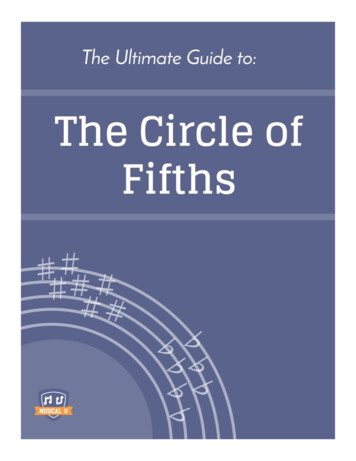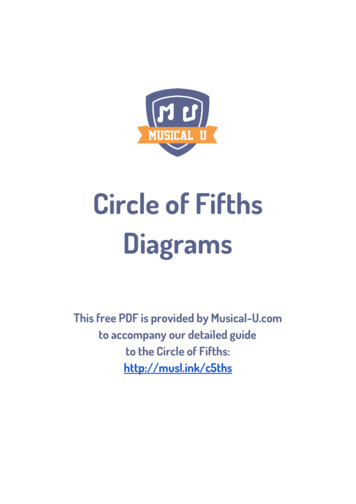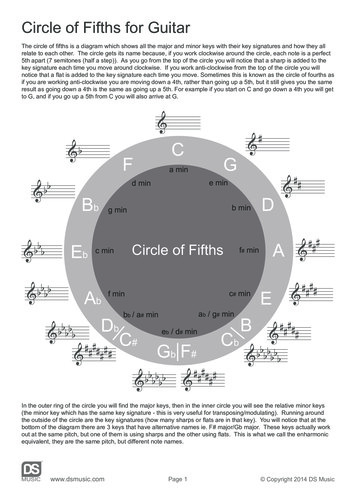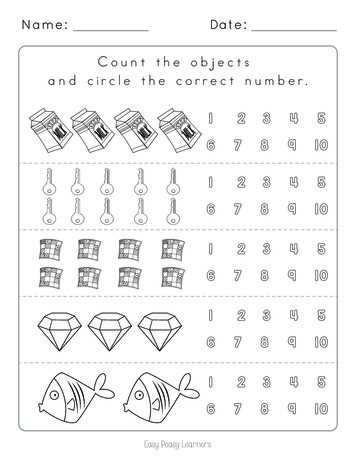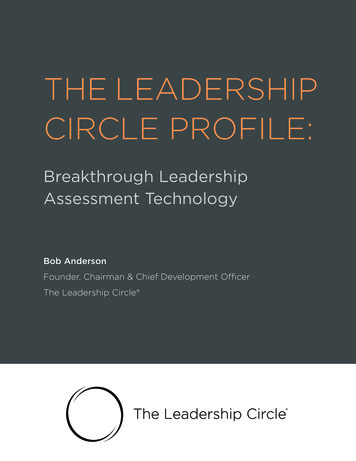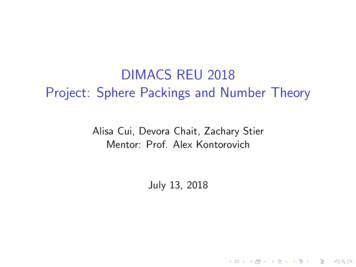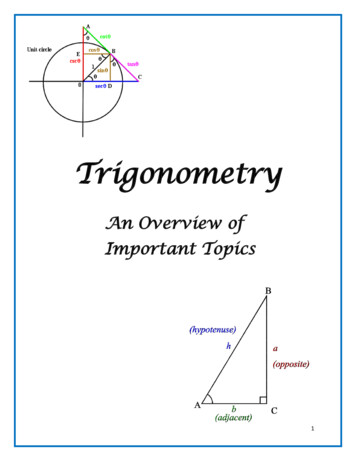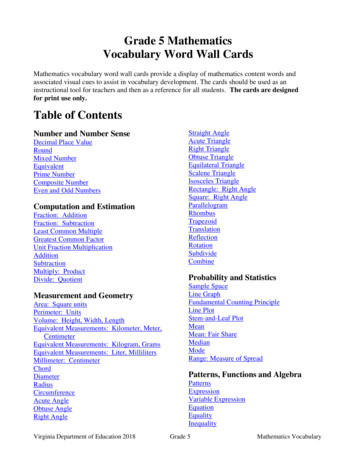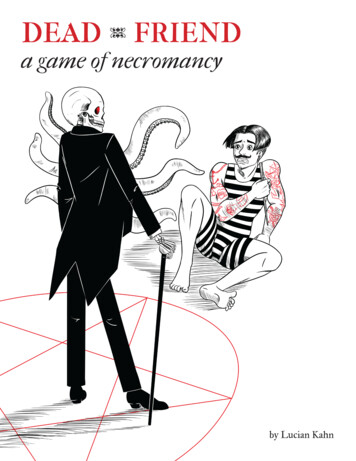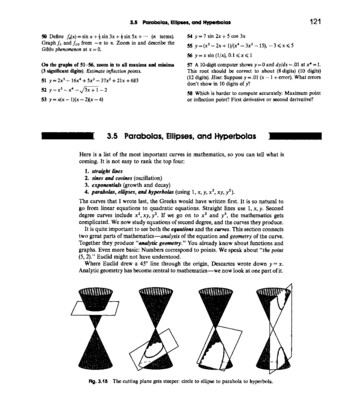
Transcription
The Circleof FifthsThe Circle of FifthsTony R.KuphaldtGECAFDThe CircleWhy jormajorIntervalsAGF#EDC#BAGF#EDC#ScalesTension C#AmajormajorKeysBuilding theCircleSo rcle of tonesCircle ofchordsCircle of keysPractice #ED#C#
The Circleof FifthsTony R.KuphaldtThe CircleWhy Study Music Theory?Why Theory?PurposeAssumptionsMany extremely proficient musicians play quite well with littleor no knowledge of music theory, so why study it?IntervalsScalesTension andResolutionKeysBuilding theCircleSo What?Circle of tonesCircle ofchordsCircle of keysPractice IdeasGlossaryCopyrightThe answer is very practical and very simple: music theorysaves you from having to learn by trial and error, and thatmakes the learning process faster!This tutorial begins with a review of intervals, scales, and keys.After that, it explores how the Circle of Fifths is constructedand what it means.
The Circleof FifthsTony R.KuphaldtThe CircleWhy Theory?PurposeThe Purpose of This TutorialThis tutorial will teach you to understand the meaning of theCircle of Fifths. Mastering these concepts will enable you to:AssumptionsIntervals More easily find the right tones when playing by earScales Identify the “key” of a tune or song from the number ofTension andResolutionsharps or flats in the key signatureKeysBuilding theCircleSo What?Circle of tonesCircle ofchordsCircle of keysPractice IdeasGlossaryCopyrightYou will maximize your learning by experimenting with all theseconcepts on your instrument(s) while you read the tutorial.Any text set in italicized red denotes an exercise recommendedfor immediate application or a question for you to answer.
The Circleof FifthsTony R.KuphaldtThe CircleWhy Theory?Starting n andResolutionKeysBuilding theCircleSo What?Circle of tonesCircle ofchordsCircle of keysPractice IdeasGlossaryCopyrightThis tutorial assumes prior knowledge of certain music theorytopics, including intervals, scales, and keys. A review of thesetopics precedes the main tutorial on the Circle of Fifths.This tutorial also assumes a context of Western music,particularly the common genres of folk and classical. In otherwords, nothing too crazy . . .
The Circleof FifthsIntervalsTony R.KuphaldtThe CircleWhy Theory?PurposeA musical interval is the difference1 in pitch between twotones. The basic unit of measurement for intervals is the step.AssumptionsIntervalsScalesTension andResolutionKeysBuilding theCircleSo What?Circle of tonesCircle ofchordsCircle of keysOne half-step is the difference in pitch between two successivefrets on a guitar, or between two immediately adjacent keys ona piano. When we modify a natural tone to make it either“sharp” or “flat” we are applying a half-step interval.One whole-step is equal to two half-steps: a distance of twofrets on a guitar, or two keys on a piano with one key inbetween.Whole- and half-steps are alternatively referred to aswhole-tone and semi-tone intervals.Practice IdeasGlossaryCopyright1Mathematically, an interval is a ratio of pitch frequencies.
The Circleof FifthsHalf- and whole-step examplesTony R.KuphaldtThe CircleWhy lestepGuitar fretboardIntervalsScalesTension andResolutionKeysBuilding theCircleSo What?Circle of tonesCircle ofchordsCircle of keysPractice fstepHalfstepWholestepTry playing half-step and whole-step intervals on yourinstrument to explore what they sound like!How many steps are in one octave (i.e. the point at which thetone-letters repeat)? Prove it by playing a one-octave intervalon your instrument!
The Circleof FifthsIntervals2 through one octaveTony R.KuphaldtThe CircleWhy Theory?Each octave is a doubling of pitch, which is why you get anoctave tone when you fret a string at half-length.PurposeAssumptionsStepsInterval nameIntervals(none)Perfect UnisonP120/12 1.000 or 1:1HMinor Secondm221/12 1.059 16:15WScalesTension andResolutionKeysBuilding theCircleSo What?Circle of tonesMajor SecondM222/12 1.122 9:8W HMinor Thirdm323/12 1.189 6:52WMajor ThirdM324/12 1.2599 5:42W HPerfect FourthP425/12 1.335 4:33WAugmented Fourth(a.k.a. "tri-tone")Diminished Fifthaug426/12 1.414 17:12Perfect FifthP527/12 1.498 3:24WMinor Sixthm628/12 1.587 8:5Major SixthM629/12 1.682 5:3Minor Seventhm7210/12 1.782 9:55WCircle of keysdim53W H4W HCircle ofchordsSymbol Approximate pitch ratio5W HMajor SeventhM7211/12 1.888 15:86WPerfect OctaveP8212/12 2.000 or 2:1Practice IdeasGlossaryCopyright2Pitch ratios vary slightly according to how the instrument isconstructed and tuned, an advanced concept called temperament.
The Circleof FifthsTony R.KuphaldtIntervals define melodiesThe CircleWhy Theory?PurposeAssumptionsIntervalsScalesTension andResolutionThe defining tonal characteristic of any melody are theintervals between successive tones. The actual tones don’tmatter so long as the intervals remain unchanged.Try playing the first few tones of “Mary Had A Little Lamb”beginning with E: E-D-C-D-E-E-EKeysBuilding theCircleNow try playing the same sequence of intervals beginning withB instead of E: B-A-G-A-B-B-BSo What?Circle of tonesCircle ofchordsCircle of keysPractice IdeasGlossaryCopyrightIn either case the melody is still “Mary Had A Little Lamb”despite using completely different tones because the sameintervals (whole-steps) are used in each case!
The Circleof FifthsTony R.KuphaldtScalesThe CircleWhy Theory?PurposeAssumptionsIntervalsScalesTension andResolutionKeysBuilding theCircleSo What?Circle of tonesCircle ofchordsCircle of keysPractice IdeasGlossaryCopyrightA scale is a particular sequence of tones played in eitherascending or descending order of pitch. Any such sequence isfair to call a “scale,” but some scales are more common thanothers.Examples of common scale types include major, natural minor,and harmonic minor.The pattern of intervals between scale-tones defines the quality(major, minor) of that scale. Every major scale, for example,exhibits the exact same interval pattern between its tones.
The Circleof FifthsMajor scalesTony R.KuphaldtThe CircleWhy Theory?PurposeMajor scales follow the interval3 sequence W-W-H-W-W-W-H.C major and F-sharp major are shown as examples:AssumptionsC major scale:IntervalsCScalesDEFGABCTension epWholestepWholestepHalfstepBuilding theCircleSo What?F# major scale:Circle of tonesF#G#A#C#BD#E#Circle ofchordsWholestepCircle of keysWholestepHalfstepWholestepPractice IdeasGlossaryCopyright3W Whole step ; H Half stepWholestepWholestepHalfstepF#
The Circleof FifthsNatural minor scalesTony R.KuphaldtThe CircleWhy Theory?PurposeNatural minor scales follow the interval4 sequenceW-H-W-W-H-W-W. Again, C and F-sharp are shown as scaleexamples:AssumptionsC natural minor scale:IntervalsScalesCTension WholestepHalfstepBbWholestepCWholestepBuilding theCircleSo What?F# natural minor scale:Circle of tonesF#Circle ofchordsCircle of keysG#WholestepPractice ht4W Whole step ; H Half stepDHalfstepEWholestepF#Wholestep
The Circleof FifthsHarmonic minor scalesTony R.KuphaldtThe CircleWhy Theory?PurposeHarmonic minor scales follow the interval5 sequenceW-H-W-W-H-(W H)-H. Again, C and F-sharp are shown asscale examples:AssumptionsC harmonic minor scale:IntervalsScalesCTension WholestepHalfstepBCWhole Half HalfstepstepBuilding theCircleSo What?F# harmonic minor scale:Circle of tonesF#Circle ofchordsCircle of keysG#WholestepPractice ht5W Whole step ; H Half stepDHalfstepE#Whole Half HalfstepstepF#
The Circleof FifthsTony R.KuphaldtThe CircleWhy Theory?PurposeAssumptionsIntervalsScalesTension andResolutionKeysBuilding theCircleSo What?Circle of tonesCircle ofchordsCircle of keysPractice IdeasGlossaryCopyrightScale DegreesA common way to describe tones within a scale is by theirnumerical order in the sequence. The beginning tone of anyscale is called the tonic and is numbered as degree 1.Successive ascending tones are numbered accordingly.For example, the scale of C major (C-D-E-F-G-A-B-C) wouldhave its tones labeled 1-2-3-4-5-6-7-8 respectively. Notice thatthe last tone in this scale (C) is the eighth degree, which is whyit is called the octave.Since we know that intervals really define the tonalcharacteristic of any musical piece, we may describe a melodyby its degree number rather than by tone letters. For example,the opening tones of “Mary Had A Little Lamb” could bedescribed as 3-2-1-2-3-3-3 regardless of the starting tone (e.g.E-D-C-D-E-E-E, B-A-G-A-B-B-B, etc.):
The Circleof FifthsTension and ResolutionTony R.KuphaldtThe CircleWhy Theory?PurposeAssumptionsIntervalsTwo important concepts in music are tension and resolution.These are subjective terms, referring to sensations experiencedby the listener when hearing different intervals within a scale ortune.ScalesKeysResolution may be easily illustrated by playing a major scale.For example, try playing the D major scale shown here:Building theCircleD-E-F# -G-A-B-C# -DTension andResolutionSo What?Circle of tonesCircle ofchordsCircle of keysPractice IdeasGlossaryCopyrightThat sense of completion or satisfaction upon returning to theoctave D tone is the musical phenomenon of the scale resolvingto its tonic. The scale begins on D, then increases pitch inwhole- and half-steps, and finally “returns home” to D.
The Circleof FifthsTension and ResolutionTony R.KuphaldtThe CircleWhy Theory?PurposeAssumptionsIntervalsScalesTension andResolutionKeysBuilding theCircleSo What?Tension may be illustrated just as easily by playing a partialscale. Try playing the D major scale again, but this time stopshort of playing the entirety. Some examples are shown here:D-E-F# -G-A-B-C# . . .D-E-F# -G-A-B . . .That sense of incompleteness or irresolution created by thepartial scale is the musical phenomenon of tension.Circle of tonesCircle ofchordsCircle of keysPractice IdeasGlossaryCopyrightIn playing partial D major scales, which ending degrees of thescale result in the greatest tension?
The Circleof FifthsTony R.KuphaldtThe CircleWhy Theory?PurposeTension and ResolutionTension and resolution make tunes interesting, much likestorytelling: tension in a story builds to a climax, after whichthere is resolution.AssumptionsIntervalsScalesTension andResolutionKeysBuilding theCircleSo What?Circle of tonesCircle ofchordsCircle of keysPractice IdeasGlossaryCopyrightNot all melodies end in perfect resolution, although many do.A compositional technique used in many folk tunes is to endthe tune on a non-resolving note (i.e. end with a feeling oftension) but begin again either on the resolving tone or on onewith less tension than the last. This makes everyone want torepeat the tune in order to make it seem “complete”.An example of this is the traditional Irish slip jig Drops OfBrandy which ends on an E note although the tune is clearlycentered around D. Another example is the traditional Irish reelThe Wind That Shakes The Barley which is also centeredaround D but ends on a B note.
The Circleof FifthsTony R.KuphaldtThe CircleWhy Theory?PurposeAssumptionsIntervalsScalesTension andResolutionKeysBuilding theCircleSo What?Circle of tonesCircle ofchordsCircle of keysPractice IdeasGlossaryCopyrightKeysA key is a set of tones representing a musical “palette” fromwhich tunes may be made, centered around one particular tonecalled the tonic. When played as a scale, the tonic will be thefirst and last tone of that scale and is the resolving tone for anymelody constructed from that key.For example, the key of A major consists of all the tonescomprising an A major scale (A-B-C# -D-E-F# -G# -A). A key,however, does not imply any particular order of playing as doesa scale; e.g. the key of A major is still the key of A major if thetones aren’t played in strict ascending or descending order.A musical piece written in a particular key need not begin onthe tonic tone, but it often “resolves” to the tonic at theclosure of the piece and at certain critical points between.
The Circleof FifthsKey signaturesTony R.KuphaldtThe CircleWhy Theory?PurposeA cluster of sharp or flat symbols drawn near the clef insheetmusic marks all the non-natural tones in that key. Someof the more common key signatures are shown here:AssumptionsIntervalsKey of G major (1 sharp)Key of C major (no sharps or flats)ScalesTension andResolutionKeysBuilding theCircleSo What?G A B C D E F#Key of D major (2 sharps)C D E F G A BKey of F major (1 flat)D E F# G A B C#Key of A major (3 sharps)F G A Bb C D EbKey of B major (2 flats)Circle of tonesCircle ofchordsCircle of keysPractice IdeasGlossaryCopyrightA B C# D E F# G#Key of E major (4 sharps)E F# G# A B C# D#Bb C D Eb F G AKey of Eb major (3 flats)Eb F G Ab Bb C D
The Circleof FifthsKey signaturesTony R.KuphaldtThe CircleWhy Theory?PurposeAssumptionsIntervalsIt is important to realize that a key signature alone does notdefine the key of a tune. All it defines are the tones used withinthat key. For example, compare these two different keys havingthe exact same signatures:ScalesTension andResolutionKeysKey of G major (1 sharp)Key of E minor (1 sharp)G A B C D E F#E F# G A B C DBuilding theCircleSo What?Circle of tonesCircle ofchordsCircle of keysThe difference between these two keys is the tonic: G majorresolves “G” while E minor resolves to “E” despite using theexact same tones. Try playing each of these keys as a simplescale to hear the difference!Practice IdeasGlossaryCopyrightG-A-B-C-D-E-F# -GversusE-F# -G-A-B-C-D-E
The Circleof FifthsTony R.KuphaldtKey resolutionThe CircleWhy Theory?PurposeAssumptionsIntervalsAs we saw in the previous example, simply having a particularset of tones is not enough to define a key. An additional,essential component of any key is a resolving tone (the“tonic”) providing a “home” or “focal point”.ScalesTension andResolutionKeysBuilding theCircleDetermining the key of any melody is therefore not asstraight-forward as simply identifying the key signature. Wemust listen to the piece in order to determine which tone itresolves to, which then gives us the letter-name of that key.So What?Circle of tonesCircle ofchordsCircle of keysPractice IdeasGlossaryCopyrightGenerally speaking, the resolving tone will be the letter-nameof the last note played. However, bear in mind that some tunesdon’t end in perfect resolution, but rather purposely end intension for artistic effect!
The Circleof FifthsTony R.KuphaldtKey resolutionThe CircleWhy Theory?PurposeAssumptionsIntervalsScalesTension andResolutionKeysBuilding theCircleSo What?Try playing “Mary Had A Little Lamb” beginning on any toneyou wish. After picking out all the tones making up this simplemelody, see if you can determine which tone it resolves on. Agood test is this: would the melody sound complete if it endedon that tone?Does “Mary Had A Little Lamb resolve on its first tone?Does “Mary Had A Little Lamb resolve on its last tone?Circle of tonesCircle ofchordsCircle of keysPractice IdeasGlossaryCopyrightTry this same experiment playing any other tune that comes tomind. Attempt it with both major and minor tunes!
The Circleof FifthsTony R.KuphaldtThe CircleWhy Theory?PurposeBuilding the Circle of FifthsToo often the Circle of Fifths is simply presented to studentswith little or no explanation for why it exists. Here, we willbuild our own Circle of Fifths step-by-step so you can see howit is constructed.AssumptionsIntervalsScalesTension andResolutionKeysBuilding theCircleSo What?This section of the tutorial is designed to be interactive: thefollowing pages contain blanks for you to write tone letters asyou build one major scale after another. You may do this byfollowing the pattern of intervals (whole-steps and half-steps)comprising a major scale, and/or you may do this by findingthe right tones on your instrument by ear, each time listeningfor the distinctive quality of a major scale.Circle of tonesCircle ofchordsCircle of keysPractice IdeasGlossaryCopyrightFollowing each fill-in-the-blank page is another page showingthe answer, so you may check your own work. Following thatpage is another analyzing the new major key and its place inthe Circle of Fifths.
The Circleof FifthsTony R.KuphaldtThe CircleWhy Theory?PurposeAssumptionsBuilding the Circle of Fifths (continued)While this step-by-step exploration of the Circle of Fifthsencompasses the entire Circle, this may not be strictly necessaryfor your practical use. If you are a folk musician, for example,the majority of tunes are written only using keys appearing inthe upper-right quadrant of the Circle (keys of C, G, D, and A).IntervalsScalesTension andResolutionKeysBuilding theCircleSo What?Circle of tonesCircle ofchordsCircle of keysPractice IdeasGlossaryCopyrightFeel free to ignore any portion(s) of the Circle that do notapply to the music you play, if you find the full exploration tootedious.In each of these steps we will use a piano keyboard to referencetone-letters. This is done not out of a bias toward keyboardinstruments, but rather because keyboards make sense of thosetone-letters. It is not apparent, for example, why any toneshould be called “sharp” or “flat” on a guitar fretboard, but ona keyboard it makes perfect sense: the sharps and flats arecolored black while the “natural” tones are colored white.
The Circleof FifthsAn Important PatternTony R.KuphaldtThe CircleWhy Theory?PurposeWhile reviewing key signatures earlier, you may have noticed apattern as successive sharps or flats were added to eachsignature:AssumptionsIntervalsKey of G major (1 sharp)Key of C major (no sharps or flats)ScalesTension andResolutionKeysBuilding theCircleSo What?G A B C D E F#Key of D major (2 sharps)C D E F G A BKey of F major (1 flat)D E F# G A B C#Key of A major (3 sharps)F G A Bb C D EbKey of B major (2 flats)Circle of tonesCircle ofchordsCircle of keysPractice IdeasGlossaryCopyrightA B C# D E F# G#Key of E major (4 sharps)E F# G# A B C# D#Bb C D Eb F G AKey of Eb major (3 flats)Eb F G Ab Bb C D
The Circleof FifthsAdding SharpsTony R.KuphaldtThe CircleWhy Theory?PurposeStart with G major. From there, how can we tell D major willbe the next-sharper key? From D major, how may we identifyA major as next? Do you see a pattern?AssumptionsIntervalsKey of G major (1 sharp)Key of C major (no sharps or flats)ScalesTension andResolutionKeysBuilding theCircleSo What?G A B C D E F#Key of D major (2 sharps)C D E F G A BKey of F major (1 flat)D E F# G A B C#Key of A major (3 sharps)F G A Bb C D EbKey of B major (2 flats)Circle of tonesCircle ofchordsCircle of keysPractice IdeasGlossaryCopyrightA B C# D E F# G#Key of E major (4 sharps)E F# G# A B C# D#Bb C D Eb F G AKey of Eb major (3 flats)Eb F G Ab Bb C D
The Circleof FifthsAdding FlatsTony R.KuphaldtThe CircleWhy Theory?PurposeStart with C major. From there, how can we tell F major willbe the next-flatter key? From F major, how may we identifyB-flat major as next? Do you see a pattern?AssumptionsIntervalsKey of G major (1 sharp)Key of C major (no sharps or flats)ScalesTension andResolutionKeysBuilding theCircleSo What?G A B C D E F#Key of D major (2 sharps)C D E F G A BKey of F major (1 flat)D E F# G A B C#Key of A major (3 sharps)F G A Bb C D EbKey of B major (2 flats)Circle of tonesCircle ofchordsCircle of keysPractice IdeasGlossaryCopyrightA B C# D E F# G#Key of E major (4 sharps)E F# G# A B C# D#Bb C D Eb F G AKey of Eb major (3 flats)Eb F G Ab Bb C D
The Circleof FifthsTony R.KuphaldtThe Patterns RevealedThe CircleWhy Theory?PurposeAssumptionsIntervalsScalesTension andResolutionAdding sharps: to identify the tonic of the next-sharper key,just look at the fifth degree of the major key you’re currentlyin. This is why G major leads to D major: D is the fifth-degreetone in the G major key.KeysBuilding theCircleSo What?Circle of tonesCircle ofchordsCircle of keysPractice IdeasGlossaryCopyrightAdding flats: to identify the tonic of the next-flatter key, justlook at the fourth degree of the major key you’re currently in.This is why C major leads to F major: F is the fourth-degreetone in the C major key.
The Circleof FifthsTony R.KuphaldtThe CircleWhy Theory?PurposeAssumptionsIntervalsScalesTension andResolutionKeysBuilding theCircleSo What?Circle of tonesCircle ofchordsCircle of keysPractice IdeasGlossaryCopyrightA Circle RevealedIf we keep following either of these patterns, we will end upcovering all twelve major keys and return where we started. Inother words, the sequence of major keys in order of number ofsharps or flats in the key signature forms a circle. This is whywe call it the Circle of Fifths: by picking the fifth-degree toneof each key as the tonic of the next-sharper key, we may plot acircle of all twelve keys (going clockwise). Of course, we couldalso form the same circle by picking fourth-degree tones andgoing counter-clockwise, which is why the same Circle isalternatively called the Circle of Fourths.What comes next in this tutorial is a step-by-step constructionof the Circle of Fifths, by picking the fifth-degree tone of eachmajor key as the tonic of the next key. We will do this twelvetimes in order to prove that the sequence forms a completecircle.
The Circleof FifthsThe Key of C MajorTony R.KuphaldtThe CircleWhy Theory?Select the proper tone letters from the piano keyboard to forma C major scale:PurposeAssumptionsIntervalsC# D#Db EbScalesTension andResolutionF# G# A#Gb Ab BbC# D#Db EbF# G# A#Gb Ab BbKeysCBuilding theCircleDEFGABCDEFGABSo What?Circle of tonesCircle ofchordsCCCircle of keysPractice olestepWholestepWholestepHalfstep
The Circleof FifthsThe Key of C Major (answer)Tony R.KuphaldtThe CircleWhy Theory?PurposeAssumptionsIntervalsScalesTension andResolutionCKeysDEFGABCDEFGABBuilding theCircleSo What?Circle of tonesCDEFGABCCircle ofchordsCircle of keysPractice olestepWholestepWholestepHalfstep
The Circleof FifthsTony R.KuphaldtThe CircleWhy Theory?The Key of C MajorC major is the first key in the Circle. It contains no sharps orflats, only “natural” tones:PurposeAssumptionsIntervalsScalesCTension andResolutionCBAGFEDCmajorKeysBuilding theCircleSo What?Circle of tonesCircle ofchordsCircle of keysPractice IdeasGlossaryCopyrightThe next-clockwise key’s tonic will be the fifth degree of thiskey: C-D-E-F-G-A-B-C
The Circleof FifthsThe Key of G MajorTony R.KuphaldtThe CircleWhy Theory?Select the proper tone letters from the piano keyboard to forma G major scale:PurposeAssumptionsIntervalsC# D#Db EbScalesTension andResolutionF# G# A#Gb Ab BbC# D#Db EbF# G# A#Gb Ab BbKeysCBuilding theCircleDEFGABCDEFGABSo What?Circle of tonesCircle ofchordsGGCircle of keysPractice olestepWholestepWholestepHalfstep
The Circleof FifthsThe Key of G Major (answer)Tony R.KuphaldtThe CircleWhy n andResolutionCKeysDEGABCDEGABBuilding theCircleSo What?Circle of tonesGABCDEF#Circle ofchordsCircle of keysPractice olestepWholestepWholestepHalfstepG
The Circleof FifthsTony R.KuphaldtThe CircleWhy Theory?PurposeAssumptionsIntervalsScalesTension andResolutionKeysBuilding theCircleSo What?Circle of tonesCircle ofchordsThe Key of G Major (continued)The reason why we name the one non-natural note F-sharpinstead of G-flat is to ensure we use each of the seventone-letters exactly once before reaching the octave.The right way:G-A-B-C-D-E-F# -G Each of the letters are here!The wrong way:G-A-B-C-D-E-Gb -G Where is the F? Why the extra G?Even though the labels F# and Gb are technicallyinterchangeable, one makes more sense than the other if we’retrying to represent all seven tone-letters.Circle of keysPractice IdeasGlossaryCopyrightThis naming convention will become more important as weprogress around the Circle of Fifths!
The Circleof FifthsTony R.KuphaldtThe CircleWhy Theory?The Key of G MajorG major is one step clockwise from C major in the Circle. Itcontains one sharp tone (F# ajorGmajorTension andResolutionGF#EDCBAGKeysBuilding theCircleSo What?Circle of tonesCircle ofchordsCircle of keysPractice IdeasGlossaryCopyrightThe next-clockwise key’s tonic will be the fifth degree of thiskey: G-A-B-C-D-E-F# -G
The Circleof FifthsThe Key of D MajorTony R.KuphaldtThe CircleWhy Theory?Select the proper tone letters from the piano keyboard to forma D major scale:PurposeAssumptionsIntervalsC# D#Db EbScalesTension andResolutionF# G# A#Gb Ab BbC# D#Db EbF# G# A#Gb Ab BbKeysCBuilding theCircleDEFGABCDEFGABSo What?Circle of tonesCircle ofchordsDDCircle of keysPractice olestepWholestepWholestepHalfstep
The Circleof FifthsThe Key of D Major (answer)Tony R.KuphaldtThe CircleWhy nsion andResolutionDKeysEGABDEGABBuilding theCircleSo What?Circle of tonesDEF#GABC#DCircle ofchordsCircle of keysPractice olestepWholestepWholestepHalfstep
The Circleof FifthsTony R.KuphaldtThe CircleWhy Theory?The Key of D MajorD major is one step clockwise from G major in the Circle. Itcontains two sharp tones (F# and C# ):PurposeGECAFDAssumptionsIntervalsScalesTension rDmajorDC#BAGF#EDBuilding theCircleSo What?Circle of tonesCircle ofchordsCircle of keysPractice IdeasGlossaryCopyrightThe next-clockwise key’s tonic will be the fifth degree of thiskey: D-E-F# -G-A-B-C# -D
The Circleof FifthsThe Key of A MajorTony R.KuphaldtThe CircleWhy Theory?Select the proper tone letters from the piano keyboard to forman A major scale:PurposeAssumptionsIntervalsC# D#Db EbScalesTension andResolutionF# G# A#Gb Ab BbC# D#Db EbF# G# A#Gb Ab BbKeysCBuilding theCircleDEFGABCDEFGABSo What?Circle of tonesCircle ofchordsAACircle of keysPractice olestepWholestepWholestepHalfstep
The Circleof FifthsThe Key of A Major (answer)Tony R.KuphaldtThe CircleWhy Theory?PurposeAssumptionsF# G#C#C#F# G#IntervalsScalesTension andResolutionDKeysEABDEABBuilding theCircleSo What?Circle of tonesABC#DEF#G#ACircle ofchordsCircle of keysPractice olestepWholestepWholestepHalfstep
The Circleof FifthsThe Key of A MajorTony R.KuphaldtThe CircleWhy Theory?A major is one step clockwise from D major in the Circle. Itcontains three sharp tones (F# , C# , and G# ):PurposeGECAFDAssumptionsIntervalsScalesTension #EDC#BAGF#EDC#DmajorKeysBuilding theCircleSo What?AmajorAG#F#EDC#BACircle of tonesCircle ofchordsCircle of keysPractice IdeasGlossaryCopyrightThe next-clockwise key’s tonic will be the fifth degree of thiskey: A-B-C# -D-E-F# -G# -A
The Circleof FifthsThe Key of E MajorTony R.KuphaldtThe CircleWhy Theory?Select the proper tone letters from the piano keyboard to forman E major scale:PurposeAssumptionsIntervalsC# D#Db EbScalesTension andResolutionF# G# A#Gb Ab BbC# D#Db EbF# G# A#Gb Ab BbKeysCBuilding theCircleDEFGABCDEFGABSo What?Circle of tonesCircle ofchordsEECircle of keysPractice olestepWholestepWholestepHalfstep
The Circleof FifthsThe Key of E Major (answer)Tony R.KuphaldtThe CircleWhy Theory?PurposeAssumptionsC# D#F# G#C# D#F# G#IntervalsScalesTension andResolutionEKeysABEABBuilding theCircleSo What?Circle of tonesEF#G#ABC#D#ECircle ofchordsCircle of keysPractice olestepWholestepWholestepHalfstep
The Circleof FifthsTony R.KuphaldtThe CircleWhy Theory?The Key of E MajorE major is one step clockwise from A major in the Circle. Itcontains four sharp tones (F# , C# , G# , and D# ):PurposeGECAFDAssumptionsIntervalsScalesTension #EDC#BAGF#EDC#DmajorKeysABuilding theCirclemajorSo What?ECircle of tonesCircle ofchordsmajorAG#F#EDC#BAG#F#EDC#ED#C#BAG#F#ECircle of keysPractice IdeasGlossaryCopyrightThe next-clockwise key’s tonic will be the fifth degree of thiskey: E-F# -G# -A-B-C# -D# -E
The Circleof FifthsThe Key of B MajorTony R.KuphaldtThe CircleWhy Theory?Select the proper tone letters from the piano keyboard to forma B major scale:PurposeAssumptionsIntervalsC# D#Db EbScalesTension andResolutionF# G# A#Gb Ab BbC# D#Db EbF# G# A#Gb Ab BbKeysCBuilding theCircleDEFGABCDEFGABSo What?Circle of tonesCircle ofchordsBBCircle of keysPractice olestepWholestepWholestepHalfstep
The Circleof FifthsThe Key of B Major (answer)Tony R.KuphaldtThe CircleWhy Theory?PurposeAssumptionsC# D#F# G# A#C# D#F# G# A#IntervalsScalesTension andResolutionEKeysBEBBuilding theCircleSo What?Circle of tonesBC#D#EF#G#A#Circle ofchordsCircle of keysPractice olestepWholestepWholestepHalfstepB
The Circleof FifthsThe Key of Cb Major (answer)Tony R.KuphaldtThe CircleWhy Theory?A second set of tone-letters is also possible for this key, makingB major synonymous with C-flat ma
The Circle Why Theory? Purpose Assumptions Intervals Scales Tension and Resolution Keys Building the Circle So What? Circle of tones Circle of chords Circle of keys Practice Ideas Glossary . W H Minor Third m3 2W Major Third M3 2W H Perfect Fourth P4 3W aug4 dim5 3W H Perfect Fifth P5
